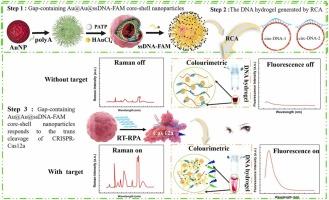Ultra-sensitive detection of norovirus using a three-in-one CRISPR platform based on a DNA hydrogel and composite functional nanomaterials
IF 12.2
1区 环境科学与生态学
Q1 ENGINEERING, ENVIRONMENTAL
引用次数: 0
Abstract
The ultrasensitive sensor with three optical response mechanisms was proposed for the determination of trace amounts of norovirus using a 3-in-1 GCSNAs (a gap-containing spherical nucleic acid nanoparticles) probe. A simple and highly sensitive three-mode biosensor with Raman, colorimetric, and fluorescence functions was proposed and implemented using the GCSNAs probe and a DNA hydrogel for norovirus detection. When the virus exists, the trans-cleavage activity of CRISPR-Cas12a was activated by double-stranded dsDNA (dsDNA) generated by reverse transcription and recombinase polymerase isothermal amplification (RT-RPA) to degrade the DNA hydrogel/GCSNA composition and release the three-in-one (3-in-1) probe-GCSNA, realising the triple ultrasensitive detection of norovirus. The colorimetric sensing mode allows for semi-quantitative on-site detection, which is visible to the naked eye and the quantitative detection can be achieved by conducting grayscale analysis using the "Colour Grab" function of a smartphone. This new triple sensor achieved the successful quantification of norovirus at concentrations as low as the femtomolar scale with an excellent selectivity and accuracy. Considering the colorimetric properties of rolling circle amplification (RCA)-based DNA hydrogels and GCSNAs, the proposed method has a broad application prospect in virus on-site detection in food. It should be applicable for virus detection in a wide range of fields such, as environmental analysis, medical diagnosis, and food safety. It is anticipated that this mechanism will open new avenues for the development of multimodal analyses and multifunctional sensing platforms for various applications. We anticipate that this sensing mechanism will open up a new way for the development of food safety detection.

利用基于 DNA 水凝胶和复合功能纳米材料的三合一 CRISPR 平台超灵敏检测诺如病毒
利用三合一 GCSNAs(一种含间隙的球形核酸纳米颗粒)探针,提出了具有三种光学响应机制的超灵敏传感器,用于检测痕量诺如病毒。利用 GCSNAs 探针和用于检测诺如病毒的 DNA 水凝胶,提出并实现了一种具有拉曼、比色和荧光功能的简单而高灵敏的三模式生物传感器。当病毒存在时,通过反转录和重组酶聚合酶等温扩增(RT-RPA)产生的双链dsDNA(dsDNA)激活CRISPR-Cas12a的反式裂解活性,降解DNA水凝胶/GCSNA成分,释放三合一(3-in-1)探针-GCSNA,实现诺如病毒的三重超灵敏检测。比色传感模式可实现肉眼可见的半定量现场检测,而定量检测则可通过使用智能手机的 "色彩抓取 "功能进行灰度分析来实现。这种新型三重传感器成功实现了对浓度低至飞摩尔级的诺如病毒的定量检测,具有极佳的选择性和准确性。考虑到基于滚动圈扩增(RCA)的 DNA 水凝胶和 GCSNA 的比色特性,所提出的方法在食品中病毒现场检测方面具有广阔的应用前景。它可用于环境分析、医疗诊断和食品安全等广泛领域的病毒检测。预计这一机制将为开发多模态分析和多功能传感平台开辟新的途径。我们预计,这种传感机制将为食品安全检测的发展开辟一条新途径。
本文章由计算机程序翻译,如有差异,请以英文原文为准。
求助全文
约1分钟内获得全文
求助全文
来源期刊

Journal of Hazardous Materials
工程技术-工程:环境
CiteScore
25.40
自引率
5.90%
发文量
3059
审稿时长
58 days
期刊介绍:
The Journal of Hazardous Materials serves as a global platform for promoting cutting-edge research in the field of Environmental Science and Engineering. Our publication features a wide range of articles, including full-length research papers, review articles, and perspectives, with the aim of enhancing our understanding of the dangers and risks associated with various materials concerning public health and the environment. It is important to note that the term "environmental contaminants" refers specifically to substances that pose hazardous effects through contamination, while excluding those that do not have such impacts on the environment or human health. Moreover, we emphasize the distinction between wastes and hazardous materials in order to provide further clarity on the scope of the journal. We have a keen interest in exploring specific compounds and microbial agents that have adverse effects on the environment.
 求助内容:
求助内容: 应助结果提醒方式:
应助结果提醒方式:


